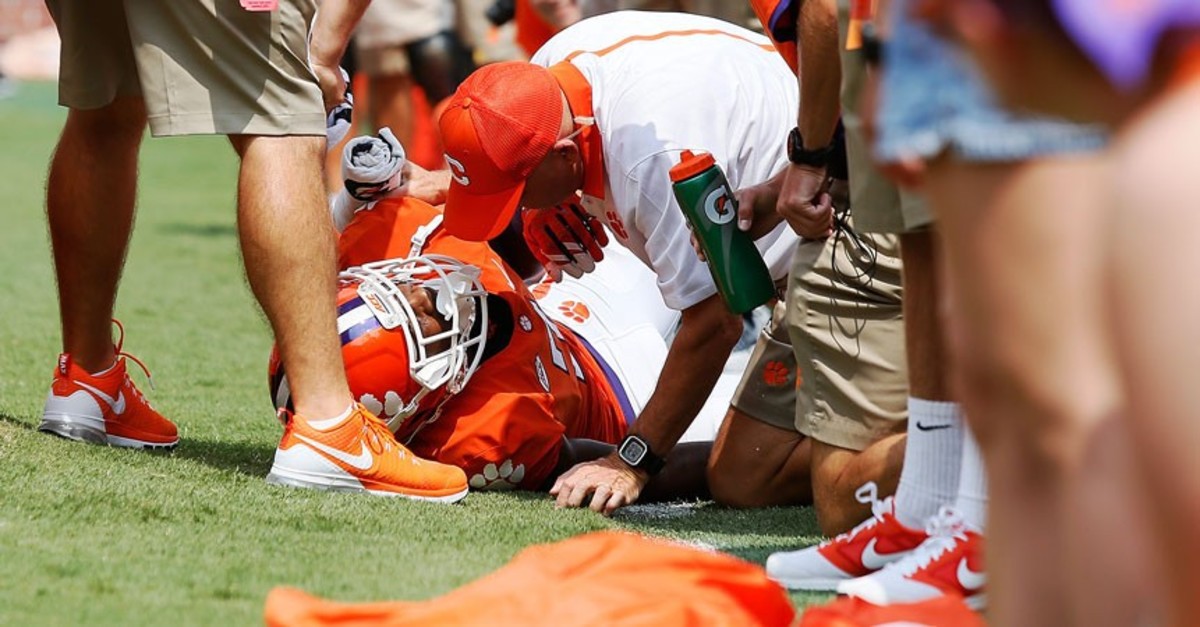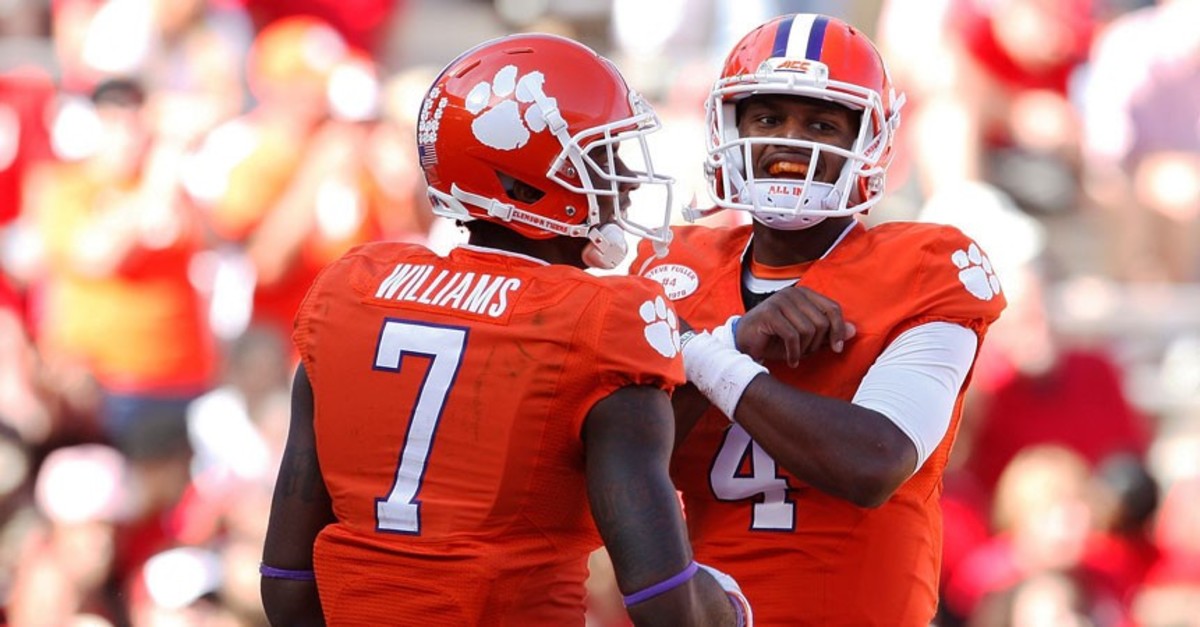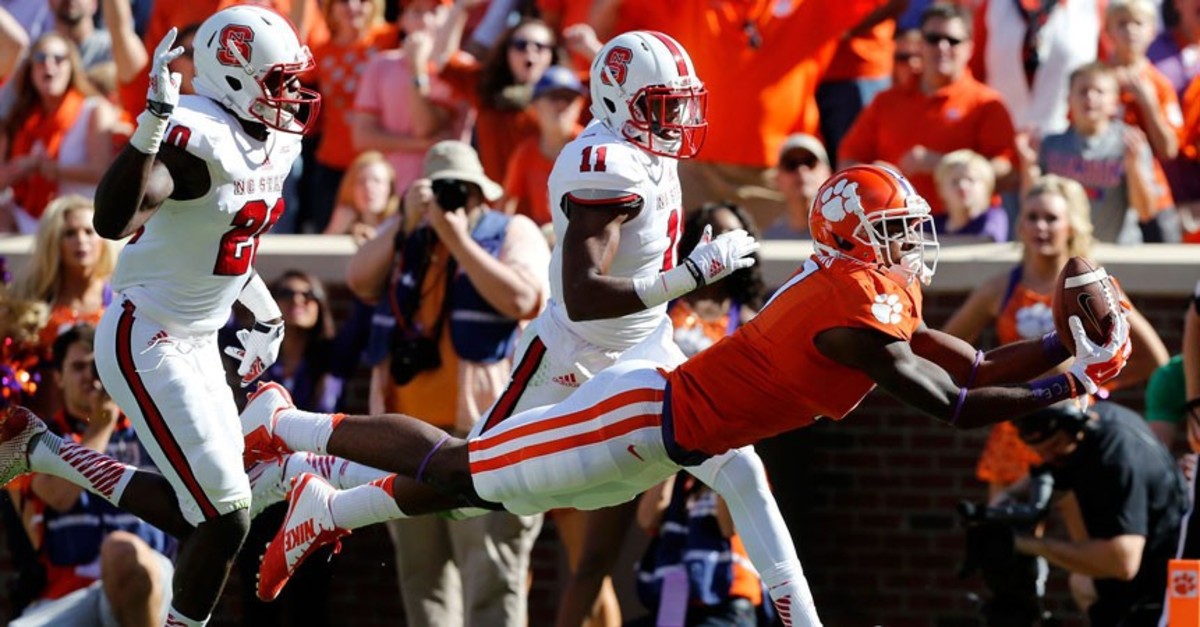After missing last season with a neck injury, Clemson star WR Mike Williams is ready for his turn in the spotlight

CLEMSON, S.C. — There are many bad things that can happen after you run full-speed into a goalpost. In the Clemson football offices one summer afternoon, Mike Williams recounts them: There is a bolt of pain followed by a shudder of total body numbness. There is getting carted off the field and rolled into an ambulance. There is the trip to Oconee Memorial Hospital ("Long ride, lots of bumps, neck hurting") and overhearing a doctor outside the room discuss a fractured vertebrae. There are the questions that fill the moments between that and the doctor actually arriving to deliver the news and answer questions. Then there is watching idly as your team embarks on one of the great seasons in program history, only to end it with a loss in the national title game, which you think may have gone differently if only you hadn't run into that goalpost.
But the worst might have been the neck brace. One of the hard ones. Williams had to wear it nearly all day every day for weeks. He had to sleep in it. He didn't have to shower in it … but doctors gave him another brace to wear for that. To look to the side, he had to rotate his shoulders like a Frankenstein monster. He had to endure teammates who thought this was very, very funny. No, last fall, this was not how the Tigers' best big-play receiver wished to turn heads—his own or anyone else's.
"On campus, everybody knows who you are now," Williams says. "There's no hiding. Everybody knows Mike Williams with the neck brace."
But time passes and bones heal and braces come off and practices and games start again. And a highly motivated 6' 4", 220-pound receiver who caught 1,030 yards of passes as a sophomore rejoins an offense run by a Heisman Trophy frontrunner (Deshaun Watson) who loves throwing to him. That offense also features a 1,000-yard rusher at tailback (Wayne Gallman), a potential All-America at tight end (Jordan Leggett) and receivers that combined for 268 catches last year, all of which makes it very difficult for defenses to plan around the guy who averaged 18 yards a catch the last time he played.
And while the poster in the Clemson receivers' room may be a little too on the nose—it features a snarling tiger face with the caption The Hungry Cat Hunts BEST—it suits the player sitting a few feet away. Williams watched as his team did great things without him. Now he has run out of patience for watching. "He's a problem," Tigers coach Dabo Swinney says. "And it's easy to see, and will show up quickly if you don't."
Whatever Wofford planned to do with Williams in the days leading up to Sept. 5, 2015, it did not work well. On the 11th snap of the season, a first-and-goal from the 4-yard line, Williams lined up on the far left side of the formation, off the line of scrimmage by a yard. At the snap, he ran what might generally and fatefully be called a post route. "Good route, good release, stick it, made eye contact," he says. Watson duly floated a pass to the back of the end zone. The ball crossed Williams's shoulder so he had to turn his body to the right as he leapt in the air to snag the ball. It would require a video replay to authenticate it, but Williams came down with his right foot inside the end zone for a touchdown on his second catch of the year.
And then.
"And then dude pushed me in my back and I just collided with the goal post," Williams says. "And that was it."

Tyler Smith/Getty Images
Wofford cornerback Chris Armfield had given Williams a seemingly innocuous nudge as the Clemson wideout came down to the turf. Williams' momentum thus accelerated, the goal post padding insufficiently cushioned his right shoulder and neck on impact. When Tigers coaches noticed their star receiver on the ground longer than he should have been, they grew deeply nervous. When they saw Williams moving a little, they recalled seeing this movie before. "There's been certain times in practice where he ran into a ball machine on the sidelines and he laid around like he broke his leg for 10 minutes," co-offensive coordinator and receivers coach Jeff Scott says. "Five minutes later he's out there going through practice. When I heard he was moving, I said, he's going to be just fine. No problem."
He was not fine. There was a problem. Williams mentioned the flash of numbness and the literal pain in the neck to medical staffers on the field and soon found himself strapped to a board and carted off the field. When Williams heard doctors discussing his test results outside of his hospital room in Seneca, S.C., he looked at his mother, more lost than worried. He had been truly injured just once in his life: As a ninth-grader, Williams tore ligaments in his ankle and missed four games. No surgery—just rest and ice. Other than that, he'd never missed a game. When doctors entered the room at last and announced the fracture to the C6 vertebrae, Williams asked if he could play again. To his relief, they confirmed he could. Then Williams asked what he had to do to get himself right again. This answer was less comforting: Nothing. The bone had to mend on its own.
After one small push forward, Williams was left at a standstill. No running for more than a month. No weightlifting at all. No activity to risk further injury to his neck, which was immobilized in that godforsaken brace. Swinney wants players to remain as engaged as their injuries permit them to be, so Williams attended practices, standing at Scott's side, where the injured star was urged to coach up younger receivers. Williams even had his own whistle. (He didn't use it, for fear of drawing the actual coaches' ire.) In meetings, Scott compelled Williams to be vocal and offer his thoughts to the group. All of it was well intentioned.
STAFF: Opposing coaches offer their thoughts on Clemson, rest of SI's Top 25
But even as Williams eventually traded the hard brace for a soft one, even after he began some light running and doing dumbbell curls about two months into recovery, the wins kept piling up and Clemson ultimately reached the national title game, where it would fall to Alabama. In its entirety, this was the wound that wouldn't heal. "That was the main (reason) why it was hard—you see your brothers out there having fun, laughing, clowning around, enjoying the game, and you just want to be a part of it," Williams says. "Then getting to the national championship and losing, you start thinking: What if I was out there?" "It's like taking one of these strong horses to the Kentucky Derby and then having them stand on the side over there on the infield and watch," Scott says. "As soon as the gates open, they want to take off and run."
Stuck in place, Williams began the process of, in essence, making Clemson's 2016 offense completely terrifying. He was left to merely observe the game and also left with more time for film review than he'd prefer, but both provided a panoramic view of his duties as a wideout and the mechanics of the offense as a whole. "When you're out there, you have corner, safety, outside linebacker who you're focusing on," Williams says. "On the sideline, you actually see what everybody is doing—what the free safety is rolling to, what the strong safety is rolling to, what this corner is doing, what that corner is doing." It was practical learning: Tigers receivers run routes based off coverage, and the more often a receiver can accurately detect what coverage he's getting, the more often he can adjust his release accordingly and get into a route that gets him into open space.
Scott insists he hears a change in Williams as much as he sees one; where Williams previously had been occupied with only the cornerback over him, he's now assessing how safety structure offers a clue to the entire defensive scheme and, in turn, how that predicts where the ball will go. In short, thanks to all the extra study time foisted upon him by a neck injury, one of the nation's best big-play wideouts is seeing things like a quarterback. "In the past, he just lined up and ran his route and hoped the ball came to him," Scott says. "There's something different in the questions he's asking and his overall understanding of how defenses would go about trying to stop him over there in the boundary."
It's menacing enough to contemplate All-America talent merged with a deeper understanding of football intricacies. And then there's the guy throwing him the ball.

Tyler Smith/Getty Images
Watson arrived on campus in the winter of 2014 as an early enrollee quarterback, and did not have to wait long for company: On Day 1, Williams says, he enticed Watson to join him in the indoor practice facility to run routes. The two continued ritualistic extra work before and after practices. By the time Watson ascended into a starting role by the end of September of his freshman year, Williams was confident the two had built a connection. The results confirmed this: In Watson's first two starts, Williams amassed a combined 12 catches for 277 yards and four touchdowns.
Since, their relationship has been based on a very simple premise. "Mike says, throw it up, let me go get it," Watson says. "If you throw it in the area, either he's coming down with it, or no one's going to catch it."
Less glibly, in 2016, Clemson's Heisman Trophy caliber quarterback once again has a big target he can use to help neutralize defensive pressure—and that massive target has a keener sense of where he should go every snap. "The chemistry that [Williams] and Deshaun have—it's a game-changer for us," Swinney says. "You put it in his ZIP code and Deshaun is just confident he's going to make the play. He's a security blanket, if you will, for Deshaun."
The security blanket, on this core-of-the-earth-hot day in Clemson, is wearing a jacket. Williams rationalizes the ensemble—he prefers being warm, he says, and he doesn't stay outside that long anyway—but it suggests a man who is not terribly affected by his circumstances. The large chart on the wall just a few steps away offers a few more clues about this.
STAFF: Clemson checks in at No. 2 in SI's preseason Top 25
Under the heading SPRING 2016 WR STATS, an incomplete record of what every Tigers receiver did and didn't do during spring practices is displayed for all to see. (Clemson filled out the numbers through the first 11 practices, and apparently the final four didn't make the wall, and the school declined a request to round out the final totals.) Though it amounts to only a partial glance, it is still useful insight into the trajectory of a star's recovery; at the start of the workouts, Williams hadn't completed a full day of football in eight months. His 39 receptions through 11 practices nevertheless tied with Trevion Thompson for second place behind Hunter Renfrow's 45—and Williams missed two workouts. As tellingly, coaches dinged Williams for three "loafs" in the first practice, one apiece in the next two, and then zero after that.
"Oh, that first practice, I was winded, I was tired," Williams concedes in a line of questioning unrelated to the numbers on the wall—and it appears it did not take him long to do so.
But then Williams didn't need 11 practices to be confident of that. In Clemson's first workout of the spring, he matched up with cornerback Cordrea Tankersley, the team's top returning cover man, in a one-on-one drill. Williams went deep. Tankersley trailed him. Williams leapt for the incoming pass and Tankersley leapt with him to defend it, and the collision of bodies sent Williams to the ground. He landed on his back, and hard.
The man who broke a bone in his neck a few months earlier then rolled over and popped up. "I was like, 'Man, if this is what it's going to feel like, I'm going to be good," Williams says. "You know you're going to hit the ground. So I wasn't going to shy away from that. I was looking for that."

Ethan Hyman/Raleigh News & Observer/MCT via Getty Images
He has long since turned his gaze to Sept. 3 and a highly consequential season opener at Auburn. He says he is at a loss for words to adequately describe his anticipation for that night. He can't wait for the relative drudgery of game week prep. He can't wait for the pregame meal. He even can't wait for the wait, as Clemson will cool its heels all day before a 9 p.m. ET kickoff.
"It's prime time," Williams says. "So that makes it better."
So Mike Williams will be back on the first Saturday of September, and all that's left to ponder is if he is back, too, to where he was the instant before he hit that goal post.
STAPLES: The long shadow facing Gus Malzahn and Auburn; Punt, Pass & Pork
His position coach, Scott, has been asked this numerous times. When he answers, the Tigers assistant considers that his Clemson offense is at its best when it has a receiver in the boundary that can win one-on-one matchups 80 to 90% of the time, which Williams can do. He considers the Heisman Trophy candidate at quarterback who has a near-telepathic connection to his best big-play target. Scott considers what he saw from Williams in the film room all year and all offseason, what he saw in the spring, what he heard about the summertime skills sessions coaches are forbidden to observe. And after all that he considers the question about Williams getting back to where he was.
"My expectation is that he's going to be better," Scott says. "I think he can be one of the best wide receivers we've had come through Clemson. And that says a lot."
If he's right, one of the most loaded offenses in the country will reintroduce one of the most game-breaking receivers anywhere. Brace yourself.
